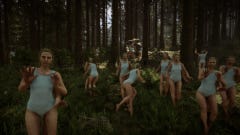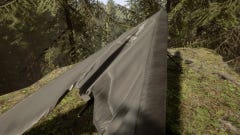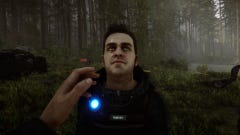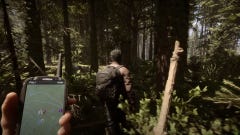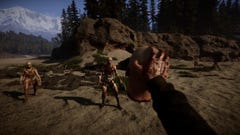Sons of the Forest system requirements, PC performance and the best settings to use
Oh, y’know, surviving
I’m not enough of a survivalist log-lugger for Sons of the Forest to be my leisure time bag, though it’s always entertaining to performance-test a PC game that’s constantly trying to kill you. This analysis and settings guide, then, is brought to you the ragged nerves of someone that’s spent several hours being screamed at by camouflaged cannibals, having only survived long enough to hear them by consuming several tins of cat food. Honestly, I am more cat food than man at this point.
Unbalanced diets aside, we must acknowledge early that Sons of the Forest is an early access game, and that some technical infidelities are to be expected. The good news is that it doesn’t run like utter dreck, and it’s not hard to boost framerates with some targeted settings changes and/or Nvidia DLSS, though a work in progress this most certainly is.
I’ve tested Sons of the Forest on a few different graphics cards, mainly from its minimum and recommended system specs, to see how this hardware really handles the cannibal-clubbing sequel. Scoot on further down this page for settings guide, or read on for a look into the game’s technical state on launch.
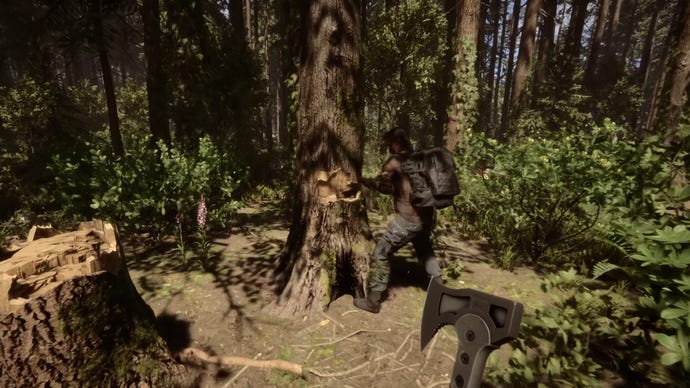
Sons of the Forest: system requirements and PC performance
Seriously, when did the GTX 1060 become every other single big-name game’s minimum GPU? Ah well, at least this time it’s just the 3GB version, alongside (a personal old favourite of mine) the Radeon RX 570. The recommended specs are, as you’d expect, a bigger ask, including an 8th-gen Core i7, the GTX 1080 Ti and the Radeon RX 5700 XT.
Sons of the Forest minimum system requirements
- GPU: Nvidia GeForce GTX 1060 3GB / AMD Radeon RX 570
- CPU: Intel Core i5-8400 / AMD Ryzen 3 3300X
- RAM: 12GB
- OS: Windows 10 64-bit
- Storage: 20GB (SSD recommended)
Sons of the Forest recommended system requirements
- GPU: Nvidia GeForce GTX 1080 Ti/ AMD Radeon RX 5700 XT
- CPU: Intel Core i5-8700K / AMD Ryzen 5 3600X
- RAM: 16GB
- OS: Windows 10 64-bit
- Storage: 20GB (SSD recommended)
There are no target framerates or monitor resolutions listed for these, though based on my testing with the RX 570 and the GTX 1080 Ti, I’m guessing they’re both for 1080p, with Ultra Low quality on the minimum spec and High or even Ultra on the recommended spec.
Perched in the RPS rig alongside its Core i5-11600K and 16GB of RAM, with display rez set to 1080p, the RX 570 averaged 50fps on Ultra Low and 49fps on Low. Framerates will be slightly lower on older or slower CPUs than the Core i5-11600K, but the listed processors should keep it more than playable on these presets. As for the GTX 1080 Ti, that could produce 67fps on Ultra, with just a tiny step up to 68fps on High. This particularly GPU might be decent for 1440p, too – I got 59fps out of it at 2560x1440 with the Medium quality preset.
For a combination of higher resolutions and higher quality, though, there’s no getting around it: you’ll need something much beefier. For what it’s worth that doesn’t have to mean top-of—the-line kit like the RTX 4090; the much more affordable RTX 3070 was decent at 4K, averaging 48fps on Ultra and 57fps with the addition of DLSS on Quality mode. It’s a good bet for fast 1440p too, scoring 71fps on Ultra at native resolution and 77fps with Quality DLSS.
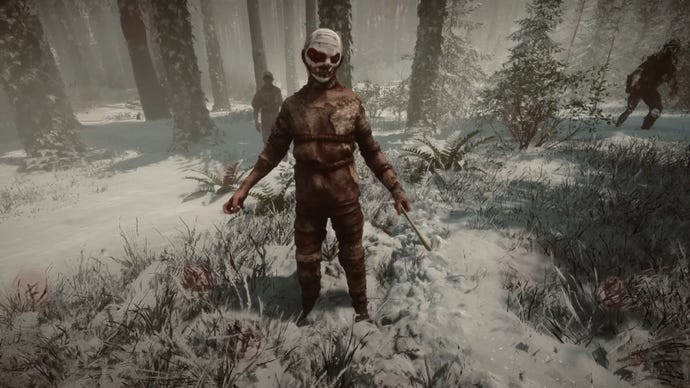
Throw in nearly two dozen individual graphics settings for togglin' and tweakin', and Sons of the Forest should have the flexibility a PC game needs to run well on a range of hardware. Except, it’s probably not to perform at its peak until it goes further through the early access motions.
It's no Kerbal Space Program 2, luckily, but it's rough in more than a couple of places. Stuttering is commonplace in the current build, as is inconsistency: a GPU that runs around 90fps in a darkened cave might drop to 50-60fps once you emerge into a thick forest. Menus could stand to be more responsive as well, when they’re not bugging out. On several occasions, hitting the pause key brought up the menu but didn’t actually pause the game, with mouse movements continuing the move the camera instead of switching to the menu cursor.
I personally haven’t had much bad luck with crashes, though guides ed Ollie found that trying to bind a mysterious 'Reset' action in the keyboard settings would kill Sons of the Forest where it stood. When I tried it, the game remained stable, though a successful rebind was never completed.
Whether this stuff should put you off playing Sons of the Forest in early access will depend on your personal level of jank tolerance. Neither I nor the guides gang have encountered anything truly game-breaking, though I would recommend saving regularly regardless.
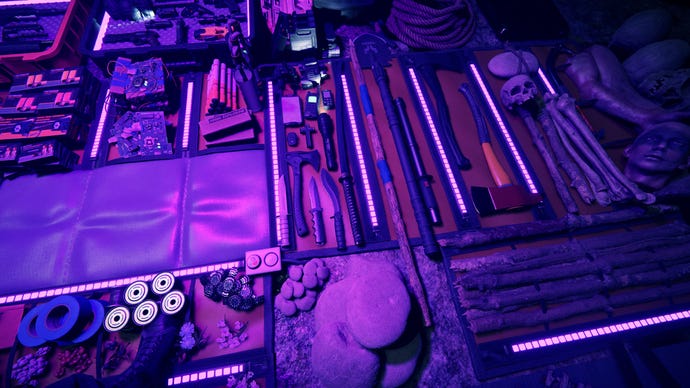
Sons of the Forest: best settings guide
Some oddities also arise when relying purely on Sons of the Forest’s graphics presets. Look at the full results of the GTX 1080 Ti at 1080p; 89fps on Ultra Low, 89fps on Low, 74fps on Medium, 68fps on High, and 67fps on Ultra. At both the top and bottom of the scale, there are two presets with either identical or near-identical performance. Why bother using Ultra Low or High at all?
As tempting as it might therefore be to slap it on Low, Medium or Ultra, you can make some finer adjustments to balance faster FPS with higher visual standards. Ultra-quality settings might be the slowest but, as you can see from the gallery below, Medium represents a sizeable drop in detail. Let’s see if we can’t find a combination of settings that’s the best of both worlds, using that Ultra test result of 67fps as a starting point.
Draw distance: Lowering this from Ultra to Medium only bumped performance up from 67fps to 69fps, though you’re about to see that this is one of the bigger possible gains from a single settings change. Worth keeping in mind.
Ambient occlusion: There was no change whatsoever after dropping AO all the way down to Low, so it’s fine to keep on Ultra.
Fog quality: Oddly, dropping this to Low actually cost a frame, resulting in a 66fps average. That might be a margin-of-error result but at least shows there’s nothing to be gained from cutting fog.
Anisotropic features: Turning this off produced a 68fps average, just 1fps faster than keeping it on. That might still be worth having if your PC is having a hard time, but if you’re just optimising already decent performance, leave this on.
Shadow quality: Another relatively profitable setting to change, with Medium quality boosting the GTX 1080 Ti to 70fps. Going even lower doesn’t seem to speed things up further.
Clouds: A switch to Low meant a small rise up to 69fps, which ain't bad.
Grass: There’s no shortage of greenery in Sons of the Forest, so I’d say you can afford to drop grass quality to Low. Doing so got the GTX 1080 Ti to 70fps.
Water: Dropping to Low didn’t add even a single frame to average FPS, so leave this one turned up as well.
Parallax distance: Again, no performance change between High and Low settings here.
Billboard quality: No actual billboards stand within this nightmare penninsula. Instead, this setting appears to govern the distance at which certain trees and bushes pop into view, and although lowering it got me a single extra frame per second, the effect is ugly; it’s distractingly noticeable when shrubs materialise just a few feet in front of you. Keep this on High if you can.
Texture resolution: Another setting where there’s little to be gained in reducing the quality. Changing from Full to Quarter resolution even hurt performance, dropping the average all the way down to 63fps. Somehow?!
Anti-aliasing: FXAA doesn’t look nearly as bad here as it does in Wild Hearts, though SMAA and the default TAA are superior alternatives. Choose whichever you like – there’s no meaningful performance difference.
Dynamic resolution: Here’s where you’ll find DLSS, as well as a peculiar FSR implementation that seems to literally act as a dynamic resolution system and not a proper upscaler like it (and DLSS) normally is. As usual, DLSS is the best option if your GPU supports it. The GTX 1080 Ti doesn’t, but on the RTX 3070, Quality DLSS produced an 8% FPS gain at 1440p and a 19% gain at 4K.
The other options, FSR and TAAU, should really only be used if you can’t get a playable framerate by lowering other settings first. You’ll also need to crank up the Dynamic Resolution Target setting: the default 70 did very little for the GTX 1080 Ti at 1080p, but after raising it to 100, both FSR and TAAU averaged 79fps. At the cost of sharpness, naturally.
Bloom: I got an extra 1fps by cutting this, so it’s not a priority.
Screen space reflection: No incremental settings here, unfortunately – just on or off. I’d leave them on, as while turning SSR off saw the GTX 1080 Ti creep up to 69fps, it’s a big loss to visual quality.
Motion blur: Now here's a setting you can turn off. Excessive motion blur was ugly in The Forest, it’s ugly in Sons of the Forest, and I got an extra 2fps out of ditching it.
Micro shadowing: While you can jettison this without a stark quality loss, the 1fps uptick that comes with doing so isn’t worth much.
Contact shadows: A 70fps result after disabling this setting makes it one of the most impactful, so consider sacrificing it.
Chromatic aberration: This doesn’t seem to make any difference to performance, one way or the other. Season to taste; it’s not the most intrusive chromatic aberration effect I’ve seen in a game, by any means.
Film grain: There’s only the tiniest of framerate gains to be had from disabling film grain, just 1fps in my case, though I’m inclined to cut it just for aesthetics.
Colour grading: These are just filters you can switch on for a bit of fun, or artful screenshotting. Black and white, sepia, that sort of thing – nothing that affects performance either way.
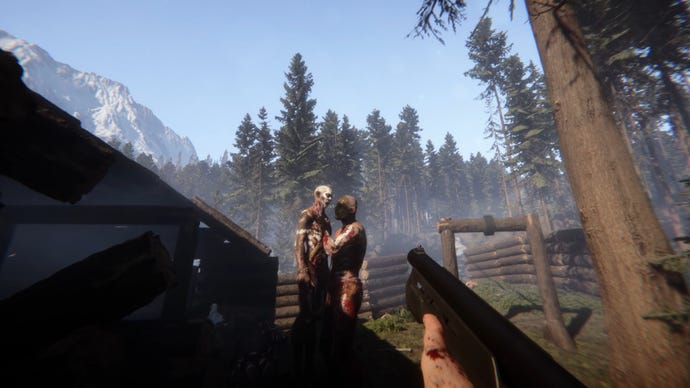
Out of this long list, there are eight settings that make prime targets for a good, firm lowering. The result should be a configuration that performs on par with, if not slightly faster than the Medium preset, while having more in common visually with Ultra…
- Draw distance: Medium
- Shadow quality: Medium
- Clouds: Low
- Grass: Low
- Motion blur: Off
- Micro shadowing: Off
- Contact shadows: Off
- Film grain: Off
- Everything else: Ultra
In the GTX 1080 Ti’s case, these settings turn that 67fps average into 83fps, or a 23% improvement. And there are more potential frames up for grabs if your graphics card supports DLSS, which I hearily recommend at 1440p and above.
It’s a shame that FSR doesn’t act like a full-on upscaler, though – this leaves AMD, Intel and Nvidia GTX cards without a real DLSS equivalent. These settings also won’t eliminate Sons of the Forest’s stuttering issue, though a higher overall framerate will insulate Sons of Forest from some of its own FPS dips.


